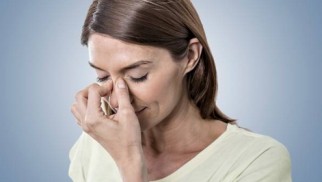What is sinusitis and how is it treated?


Sinusitis is the collective name for the inflammatory processes in one or both sinuses. It can develop as a complication of acute rhinitis, flu, common cold, other infectious diseases, as well as facial injuries.
Short information about sinusitis
Sinusitis can be caused by viruses or bacteria. The main symptoms include the feeling of heaviness in the paranasal or frontal region, pain in sharp movements of the head, dense discharge from the nose, and fever.
In children, sinusitis can be suspected if after rhinitis relief in a couple of days again develops fever and thick nasal discharges.
Classification of sinusitis

Sinusitis can be acute and chronic. Chronic usually develops as a result of untimely or insufficiently treated acute form.
By the causative agent, the disease is divided into:
- Traumatic;
- Viral (after flu or common cold);
- Bacterial;
- Fungal (usually develops based on another infection);
- Mixed;
- Allergic;
- Drug-induced.
By the affected areas, the disease is divided into:
- Maxillary – inflammation is limited to the maxillary sinus, pain is similar to a toothache;
- Frontal – inflammation is developed in the frontal sinus cavity, pain is localized above the eyes, in the forehead, headaches are common.
- Ethmoidal – inflammation of the mucous membrane of the cells of the ethmoid bone; pain is localized in the upper nose, between and behind the eyes, headaches are common.
- Sphenoidal – inflammation of the mucous membrane of the sphenoid sinus; pain is localized behind the eyes, back, and top of the head.
Symptoms of sinusitis

- Unpleasant sensations in the nose and paranasal area, nose bridge, or above the eye. The sensations intensify and are less pronounced in the morning and more pronounced in the night. Gradually pain spreads to the whole head. If only one side is affected, it can be localized in one side of the head.
- Impaired nasal breathing. Occurs nasal congestion, usually, both nostrils cannot breathe. An individual develops a nasal voice. Impaired breathing is either constant or with mild improvements. Sometimes, alternating congestion of the right and left halves of the nose occur.
- Rhinitis. In the majority of cases, a patient has clear or yellow/green nasal discharges. This symptom can be unnoticed if there is severe nasal congestion as then the outflow of discharges is impaired.
- Rise of the body temperature to 38 C (100.40 F) or more. Usually, this symptom occurs in acute maxillary sinusitis. In chronic conditions, body temperature rarely increases.
- General weakness. It is manifested also in fatigability, lack of appetite, and poor sleep.
- Frequent sneezing and sore throat.
Sinusitis in children

Usually, it is hard to distinguish sinusitis from common cold and flu. Bacterial sinusitis is suspected if a child has nasal congestion and cloudy mucus from the nose for more than ten days, suffers from general weakness, and coughs. Fever in sinusitis is rare in children. They may have pain in the face in the paranasal area.
What are the predisposition factors for sinusitis?
Although everyone can have a common cold or flu, only some people develop sinusitis. Here are the predisposing factors:
1. Congenital disorders of the anatomical structure of the nasal cavity development.
2. Nasal polyps.
3. Allergic rhinitis.
4. Deviated nasal septum.
5. Insufficient treatment of viral infections.
6. Oroantral fistula (pathology of the maxillary sinus resulting from an injury, after tooth removal, intrauterine malformations of the skull bones, inflammatory processes in the roots of the tooth).
How is sinusitis diagnosed?

If you suspect sinusitis, you should go to an otolaryngologist, a specialist who treats the diseases of the ears, nose, and throat. The diagnosis is made based on a patient’s complaints, physical examination, and x-ray of the sinuses. In cases when x-ray for some reason cannot provide the complete picture, computed tomography is used.
In some cases, doctors also appoint the x-ray of the teeth to exclude periapical abscess (accumulation of pus at the root of the tooth).
There is usually no need to make special tests for pathogen identification as a doctor can visually identify whether the process is caused by viruses or bacterial infection. However, if a patient doesn’t positively respond to the usual antibiotic therapy or in immunocompromised individuals, microbial culture can be made.
Diagnosis of sinusitis in kids
The diagnosis is made based on physical examination and rhinoscopy that allows seeing the purulent discharge in the nasal passages and excluding the presence of a foreign body.
Computed tomography is rarely used for the diagnosis in children to avoid radiation exposure. However, it should be made in the development of intracranial or eye complications when visual impairment, swelling of the eyelids, or other symptoms occur, in suspected chronic sinusitis, cancer, in facial aches, nasal bleeding, swelling of the face, and in other conditions.
The swelling of the eye that accompanies sinusitis in the child must be tested for the purulent soft tissue infection of the orbit behind the orbital septum that may require surgery to prevent vision impairment and brain infection.
Prognosis for sinusitis treatment
In general, the prognosis for the disease treatment is positive. Timely and adequate treatment allows curing the disease without any negative consequences and a person can get back to their normal life.
If adequate treatment isn’t received, the infections process can spread and cause severe health complications such as:
- Infections of the eye and surrounding tissues;
- Nasal thrombosis;
- Meningitis;
- Brain abscess;
- Bone infections.
Treatment of sinusitis

First of all, the treatment of the disease is aimed at the elimination of infection. Additional measures are aimed at reducing the severity and lasting of symptoms and prophylaxis of complications. Fir this, the free outflow of the nasal discharges must be ensured and the use of antibiotics done.
The ensuring of the outflow of the discharges and pus can be done by conservative and surgical methods. The conservative method includes sinuses lavage and the use of nasal sprays that can be done at home.
The most aggressive, surgical ensuring of drainage is chosen for patients in intensive care units in order to avoid serious blood infection.
Surgical puncture of the sinuses is needed if there are thick purulent contents. The puncture is made in severe cases and has to purposes: to clear the sinuses of pus and obtain material for microbial culture for susceptibility to antibiotics test. This treatment method is used when regular methods have no effect, the symptoms persist for a long time, or the complications of sinusitis have already developed. Another case when for sinus puncture is used is in the difficulty with choosing an antibiotic, and the low effectiveness of antibacterial therapy. In this case, it is possible to more accurately select a medication to which pathogens will not have resistance.
Symptomatic therapy
Symptomatic and supportive care includes:
- Humidification in the room.
- Drinking plenty of water.
- Smoking cessation.
- Balanced diet.
- Non-narcotic analgesics.
Antimicrobial therapy

Viral sinusitis does not need the use of antibiotics. Standard medications for treating include topical steroids, medications to reduce swelling of the mucosa, mucus thinners, and saline intranasal solutions that can be made on your own or bought as a readymade spray.
Antibacterial therapy is the main treatment for bacterial sinusitis. The choice of antibiotic is contingent on whether the disease is acute, chronic, or recurrent.
Antibiotics are prescribed for sinusitis when bacterial nature is suspected, including severe maxillary sinusitis, frontal, ethmoid, and sphenoid sinusitis, due to the greater risk of complications in these localizations. Penicillins, cephalosporins, and macrolide antibiotics show the same effectiveness. Many experts recommend a 10–14-day course of amoxicillin 500 mg thrice a day as first-choice treatment.
The antibiotic efficacy rating for bacterial sinusitis is approximately the following:
- Levofloxacin, moxifloxacin, and amoxicillin/clavulanate - more than 90%.
- Amoxicillin in high doses, cefpodoxime, cefixime, cefuroxime, and trimethoprim-sulfamethoxazole - 80-90%.
- Clindamycin, doxycycline, cefprozil, azithromycin, clarithromycin, and erythromycin - 70-80% effectiveness.
- Cefaclor - 50-60%.
Although some antibiotics seem to have lower efficacy for the sinusitis treatment, sometimes they are chosen over the other ones based on various parameters, for instance, intolerance of one or another medication, susceptibility test, if a patient had been recently using the first-line antibiotic and its effectiveness is expected to be lowered, and so on.
It is important to have a precise diagnosis and prescription for the medication before you start the treatment. However, you can save on the pills if you order them online rather than buy from a regular drugstore.
(Updated at Mar 25 / 2025)

